|
Family:
Euphorbiaceae (Poinsettia and Cassava family) Life
> eukaryotes >
Archaeoplastida >
Chloroplastida
>
Charophyta > Streptophytina > Plantae (land plants)
> Tracheophyta (vascular plants) > Euphyllophyta > Lignophyta (woody plants)
> Spermatophyta (seed plants) > Angiospermae (flowering
plants) > Eudicotyledons > Core Eudicots > Rosids >
Eurosid I > Order: Malpighiales
There are 218 genera and about 5735 species in the
Euphorbiaceae worldwide, of which 49 genera and 527 species are native to southern
Africa, six genera and 25 species are naturalised, and a further 14 genera and
43 species are cultivated in the region.
Genera native to southern Africa
Based on Archer (2000) and
Plants
of Southern Africa - an Online Checklist (SANBI).
Acalypha About 430
species, worldwide distribution in warm regions, with 29 species native to
southern Africa and an additional five species that are cultivated in the
region. |
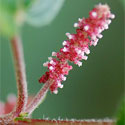 |
Adenocline Three species,
all native to southern Africa, extending as far north as Malawi. |
|
Alchornea About 50
species, native to the tropics, with three species native to southern Africa
and an additional species that is cultivated in the region. |
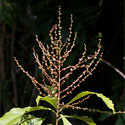 |
Androstachys
One species: Androstachys johnsonii,
native to south-eastern tropical Africa, including Zimbabwe and Mozambique. |
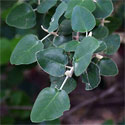 |
Argomuellera
Ten species globally, of which one
Argomuellea macrophylla is
native to southern Africa (Zimbabwe and Mozambique). |
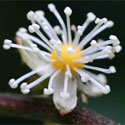 |
Caperonia About 40
species, native to tropical and subtropical regions (mainly America), with
two species native to southern Africa. |
 |
Cavacoa Three species, all
African, with one, Cavacoa aurea,
native to southern Africa. |
|
Cephalocroton Five
species, native to Africa, Socotra, Madagascar, Comoro Islands and Sri
Lanka. One species, Cephalocroton mollis,
is
native to southern
Africa. |
|
Chrozophora Ten species,
native to Europe, East Africa and Asia, with one species,
Chrozophora
plicata, native to southern Africa (Limpopo Province). |
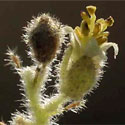 |
Clutia
Seventy-five species, all African except for two Arabian species.
Thirty-eight species native to southern Africa. |
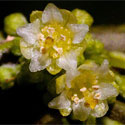 |
Croton At least 800
species, pantropical (mainly American), with 15 species native to southern
Africa, one species naturalised and a further two species that are
cultivated in the region. |
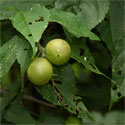 |
Dalechampia About 115
species, widely distributed in warm regions of the world, with three species
native to southern Africa. |
|
Drypetes About 200 species distributed in the
tropics and Eastern Asia, with five species native to southern Africa
(Zimbabwe and Mozambique). |
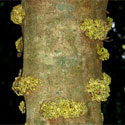 |
Erythrococca About 50
species, native mainly to Africa, with six species native to southern Africa. |
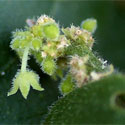 |
Euphorbia
A huge genus of at least 1600 species, occurring worldwide. A total of 280 species are native to
southern Africa, mainly succulents in arid regions. In addition, there are
11 species naturalised and a further 16 are cultivated in the region. |
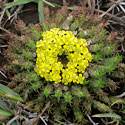 |
Excoecaria About 40
species, native from Africa through to Asia and Australia, with three
species native to southern Africa. |
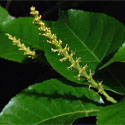 |
Jatropha About 156
species, native to the tropics and subtropics worldwide, with 24 species
native to southern Africa, three species naturalised, and a further
species that is cultivated in the region. |
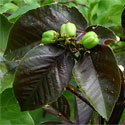 |
Leidesia
One species, Leidesia
procumbens, widespread in southern Africa. |
|
Macaranga About 300
species, native mainly to the Old World tropics. Two species in southern
Africa, Macaranga capensis
(Wild poplar) and Macaranga mellifera, native to the east coast forests. |
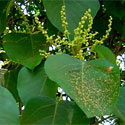 |
Mallotus
About 140 species worldwide, occurring in the Old World tropics.
One species native to southern Africa: Mallotus oppositifolius,
recorded from Zimbabwe. See
Flora of Zimbabwe. |
|
Maprounea Four species,
native to Africa and South America, with one species,
Maprounea africana,
occurring in southern Africa. |
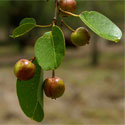 |
Micrococca Twelve species,
native to tropical Africa, Madagascar and Asia, with three species native to southern
Africa. |
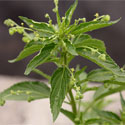 |
Mildbraedia
Two species. distributed in tropical Africa, of which one
Mildbraedia carpinifolia
is native to southern Africa (Mozambique). |
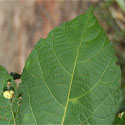 |
Monadenium About 50
species, native to Africa, with four species
native to southern Africa.
In addition, Monadenium coccineum, native to Tanzania, is cultivated
in the region. |
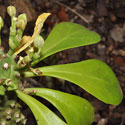 |
Necepsia
Three species, native to tropical Africa and Madagascar.
One species, Necepsia castaneifolia,
occurs in southern Africa
(recorded from Zimbabwe). |
|
Neoboutonia
Three species, distributed in tropical Africa, of which one
Neoboutonia
macrocalyx is native to southern Africa (Zimbabwe and Mozambique). |
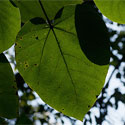 |
Plukenetia About 15
species, found mainly in the neotropics, with one Plukenetia africana
[= Pterococcus africana],
occurring in southern Africa. |
|
Schinziophyton One
species, the Manketti tree Schinziophyton rautanenii,
native to Africa, including southern Africa. |
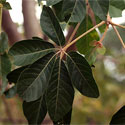 |
Sclerocroton
Six species, native to tropical Africa and Madagascar.
One species in southern Africa - Sclerocroton integerrimus [=
Sclerocroton integerrimum]. |
|
Seidelia
Three species,
endemic to southern Africa. |
|
Shirakiopsis
Six species, native from Africa through to the Pacific.
One species native to southern Africa - Shirakiopsis elliptica [= Sapium
ellipticum]. |
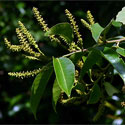 |
Spirostachys Two species, native to subtropical East
Africa and southern Africa, with one species,
Spirostachys africana (Tamboti)
occurring in southern Africa. |
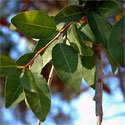 |
Suregada About 40 species,
native to the Old World tropics, with three species native to southern Africa
(eastern parts). |
|
Synadenium Nineteen
species, native to Africa, with four species
native to
southern Africa. In addition, Synadenium grantii, native to
tropical Africa, is cultivated in the region. |
 |
Tannodia
[= Neoholstia]
Nine species, native to tropical Africa and Madagascar.
One species native to southern Africa: Tannodia swynnertonii (Zimbabwe
and Mozambique). |
|
Tragia About 125 species,
found in warm regions of the world, with 26 species native to southern
Africa. |
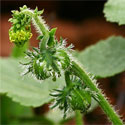 |
Tragiella
Four species,
native to Africa, with one species, Tragiella natalensis
native to southern
Africa (eastern parts). |
|
Uapaca Sixty one species worldwide, of which four
are native to southern Africa. |
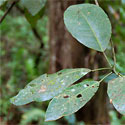 |
Genera naturalised in southern Africa
Based on Archer (2000) and
Plants
of Southern Africa - an Online Checklist (SANBI).
Aleurites
(Candlenut, Tungnut genus) The two species
are native to tropical Asia and Oceania. The Candle-nut Tree
Aleurites
moluccana is cultivated in Mpumalanga and KwaZulu-Natal and occurs as
an escape. The Tungnut tree Aleurites fordii is the source of tung
oil, which is a drying oil that is included in paints and varnishes. I know
of no record of it being cultivated in southern Africa, but it is possible. |
|
Homalanthus About 35
species, native to the Indo-Pacific region. The Bleeding-heart Tree
Homalanthus
populifolius, is cultivated in the Cape Peninsula and occurs there as
an escape. |
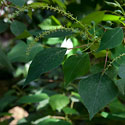 |
Manihot About 100
species, native to America. Cassava Manihot
esculenta and three other species are cultivated in tropical areas of southern Africa and
often occur as escapees. An additional species is cultivated in the
region. |
 |
Mercurialis Eight
species, native to Eurasia. Mercurialis annua
(Annual mercury) introduced to
southern Africa from Europe and found in waste places and gardens. |
|
Ricinus One species, the
Castor oil plant Ricinus communis, native to NE Africa.
Cultivated in the warmer parts of southern Africa, especially Limpopo
Province and often found as an escape. |
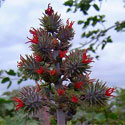 |
Vernicia Three species,
native to east and southeastern Asia. Two species are cultivated in
southern Africa and occur as escapees. |
|
Other genera, cultivated in southern Africa
List from Glen (2002). Almost all of these genera are represented by
only one species in southern Africa and hence the species name is listed rather
than the genus name.
Alchornea ilicifolia
Native to eastern Australia. |
|
Aleurites moluccana (Candle-nut
tree)
Native to tropical east Asia. |
|
Baloghia inophylla
Native to eastern Australia. |
|
Codiaeum variegatum
Native to SE Asia and Polynesia. |
|
Daphniphyllum
Two species cultivated in southern Africa - Daphniphyllum glaucescens,
native to Malaysia and Indonesia, and Daphniphyllum (Yuzuri-ha),
native to Japan, Korea and China. |
|
Fahrenheitia zeylanica |
|
Hevea brasiliensis (Pará rubber, Rubber tree)
Native to Brazil and Colombia. Sap (latex) is collected and is the main
source of natural rubber. About 42% of rubber production is natural rubber
from Rubber trees. These trees grow best in areas with high rainfall and
warm temperatures. The main growing area for these trees is SE Asia.
Synthetic rubber is derived from petroleum and has different properties to
natural rubber. |
|
Homalanthus populifolius
(Bleeding-heart tree)
Native to eastern Australia. |
|
Hura crepitans
Native from Costa Rica to Bolivia in South America. |
|
Mallotus paniculatus
Native from China to Australia. |
|
Paracroton pendulus
Native to Indian and Sri Lanka. |
|
Pedilanthus tithymaloides (Bird
cactus)
Native to South America and the West Indies. |
|
Putranjiva roxburghii (Tsuge-modoki)
Native from India to Burma. |
|
Reutealis trisperma
Native to the Philippines |
|
Publications
-
Archer, R.H. 2000. Euphorbiaceae. In: Seed Plants of
Southern Africa (ed. O.A. Leistner). Strelitzia 10: 249-262.
National Botanical Institute, Pretoria.
-
Glen, H.F. 2002. Cultivated Plants of
Southern Africa. Jacana, Johannesburg.
Text by Hamish Robertson |
